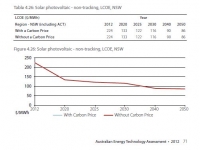 |
| The LCOE of non-tracking PV will fall by 48% from AUD$224 per MWh in 2012 to AUD$116 in 2030, and by 62% to AUD$86 in 2050. |
According to a study by the Bureau of Resources and Energy Economics (BREE), PV, along with onshore wind, will be the cheapest sources of electricity in Australia by 2030. Moreover, non-tracking PV is estimated to go on to become the cheapest power generation technology in Australia by 2050. BREE is a research unit within Australia’s Department of Resources, Energy and Tourism.
The study, which analyses 40 power generation technologies, claims that if current energy policies remain in place, PV will have one of the lowest levelized costs of electricity (LCOE) of any technology used for electricity generation by 2030; the other being onshore wind. BREE defines LCOE as the price at which electricity must be produced from a specific source to break even.
Using New South Wales as a baseline, the study estimates that the LCOE of non-tracking PV will fall by 48% from AUD$224 per MWh in 2012 to AUD$116 in 2030, and by 62% to AUD$86 in 2050. Moreover, by 2050, the average cost of single-axis and dual-axis tracking PV systems will fall to AUD$110 and $152 AUD per MWh, respectively.
The Australian government has welcomed the news as it has been pushing for a major shake-up of the renewables industry. It introduced a tax on carbon to encourage investment in greener sources of energy, including solar power, and established the Australian Renewable Energy Agency in July 2011.
BREE’s executive director Quentin Grafton is anticipating major developments within the Australian energy sector. “Australia will experience an energy transformation over the coming decades that will have a profound impact for electricity networks, how energy is distributed and on Australia’s ability to meet its targeted greenhouse gas emissions reductions.”


